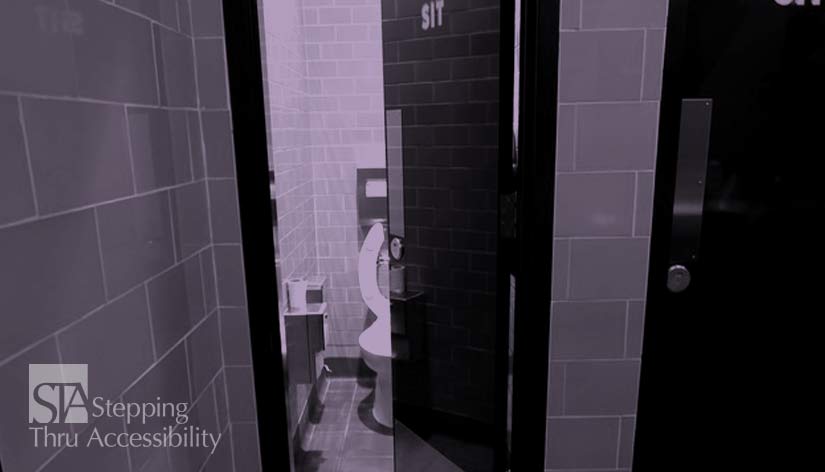Blog
Return to Blog »
Janis Kent, Architect, CASp © July, 2023 There seems to be a push for gender-neutral multi-user toilet rooms, rather than gender-specific, but, there are some points that need to be understood. So what are the issues for consideration particularly when we are seeing full height walls around a toilet in this type of configuration? Under ADA 604.8, a toilet compartment is defined as having one plumbing fixture. If there is a toilet and a lavatory or a toilet and urinal, this section specifically points you to ADA section 603 which is an individual toilet room. With the latter, the space itself would need to be enlarged to incorporate a turning space and enough space where the door does not swing into a clear floor space for any fixture. I recently came across an installation where the gender-neutral ‘multi-user’ restroom was a niche off of a corridor with a trough of 3 lavatories in the open space. The other fixtures had floor to ceiling walls with visual signs labeled Sit, Stand, or Stand/Sit. Wasn’t even sure what this was, and originally thought the sink was for the restaurant kitchen. On a closer look, I observed behind each door there was either a toilet with a urinal, two others were toilets only, two were urinals only, and another had a toilet and a baby changing station. This led to a convoluted thinking process to analyze just what this was. There were 7 plumbing fixtures behind doors in what perhaps might be considered a multi-user restroom. This would require one accessible compartment and one ambulatory compartment. This installation had no ambulatory. The door with an ISA was not located diagonally across from the toilet, so it definitely was not a compliant toilet compartment, but was it a toilet room? The California Plumbing Code, and I presume other national plumbing codes, define a Toilet Facility as a room or space containing not less than one lavatory and one water closet. With that definition, the above toilet and urinal space does not meet that requirement either. Also be aware of signage that it is compliant. Compartments are not required to be signed, but this could lead to much confusion. The Sit Stand signage may be clear to half our population, but not necessarily to the other half. Since this is labeling a permanent room (compartment?), you would most likely need to provide tactile signs. Consideration should also be given to providing more toilets than urinals so it is not limiting to the female gender. And remember, for a toilet compartment where the walls start from floor, the width of the accesible compartment is to be over 66″ clear. For a solution to the above installation, we can either move the location of the room’s door and eliminate the urinal to be a compliant compartment, or if the space is large enough we can add a lavatory for it to be considered a toilet room which is required to be accessible. We would still need an additional accessible toilet compartment, and an accessible lavatory outside of the toilet room, but no ambulatory compartment, since the single user toilet room would not be included for scoping of an ambulatory compartment. If we provide another single user toilet room in the space, it would not need to be accessible since single-user restrooms clustered in the same area require 50% accessible. Another factor is, if the compartment is located so it opens onto a common-use corridor or exterior route, it would be considered a single-user toilet room, not a compartment in a toilet room. The issue might come up as to what is considered ‘off of a corridor’, particularly if lavatories are against a low-height partition providing only partial separation, or in the above case, in an alcove off of the hallway. There is a judgement call here. And this is important because we are talking about how many accessible are actually required – 1 or 50% and the amount of space that is required. So be very careful implementing multi-user gender-neutral restrooms with toilet compartments vs single-user toilet rooms. Another option for consideration is to provide clusters of single-user gender-neutral toilet rooms. Although I have not seen a formal survey, this is actually preferred by many. The advantage is, the clusters can be spread out in a building rather than grouped in one area. A cluster is defined as being near or proximate to each other, which is generally interpreted as being adjacent or within sight of each other. And 50% of the single-user toilet rooms are to be accessible which can be rounded up or down if an odd-number. This would also have the flexibility to be used as a family toilet room or as an assisted-use toilet room. Just some thoughts. Be aware that your local City or County may have additional requirements that are more restrictive than the State or Federal requirements. Also, this article is an interpretation and opinion of the writer. It is meant as a summary – current original regulations should always be reviewed when making any decisions. © Janis Kent, FAIA, Architect, CASp 2023Gender-Neutral Toilet Compartment vs Toilet Room – What is the Difference?
